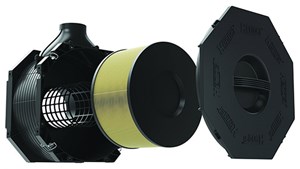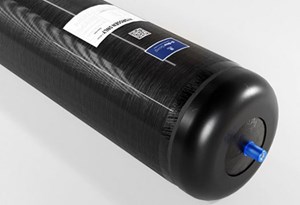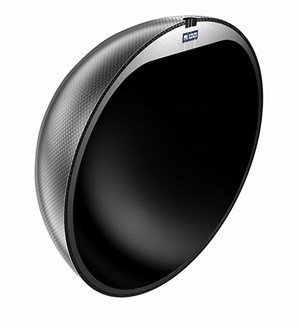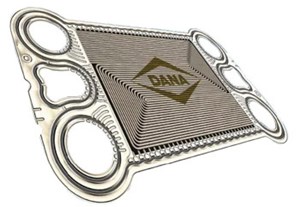Articles
H2Tech: Tech Spotlight
T. CAMPBELL, Managing Editor
H2 EQUIPMENT
Hengst presents modular system of various filtration solutions for commercial vehicles
Hengst has developed a modular set of various filtration solutions for fuel cells. During fuel cell operation, ions are introduced into the coolant, resulting from aging the coolant itself or components in the coolant circuit. Therefore, effective filtration is required to ensure the safe operation of the fuel cell. The Blue.iox ion exchanger from Hengst offers a high level of protection with minimum maintenance. The unique design of the filter cartridge with axial filter flow and the special mixed-bed resin system for cation and anion exchange ensure high filtration efficiency over the entire service interval. The ion concentration in the coolant circuit is thus reduced very rapidly.
Hengst offers various sizes in its modular program to meet the requirements of smaller systems and fuel cell systems for heavy-duty machinery, stationery and maritime applications. The Blue.iox from Hengst is also designed for easy maintenance. A screw cap enables the filter cartridge to be replaced cleanly without special tools, while integrated shut-off valves prevent coolants from escaping.
The airflow of a fuel cell also requires special filtration. The intake air must be thoroughly cleaned of airborne particles to ensure long service life and high performance. In addition, pollutants such as nitrogen oxides (NOx), ammonia and sulfur dioxide (SO2) can cause unwanted deposits in the fuel cell and damage it. A specially developed cathode air filter system from Hengst with a multilayer structure reliably protects the fuel cell components from particles and harmful gases.
Different filtration systems can be implemented, depending on the requirements and application. For example, highly effective particle filtration can be applied directly with gas filtration in a combination medium. For more stringent dust collection requirements, a pleated particulate filter medium is used as a separate filter stage upstream of the gas filtration.
Proper water management is crucial to prevent liquid water deposits and ensure the continuous effective operation of the fuel cell. The new separator module for anode gas recirculation combines the function of droplet water separation and gas drainage with an innovative configuration of the purge and drain valve.
Cummins reveals H2 internal combustion engine (ICE) heavy-duty concept truck
Cummins revealed a heavy-duty concept truck featuring the X15H hydrogen (H2) internal combustion engine (H2-ICE). The proof-of-concept installation with ratings up to 500 hp (372 kW) features a 700-bar pressure, 80-kg high-capacity H2 storage system. The H2-ICE conversion highlights the opportunity for heavy-duty truck applications to operate on zero-carbon H2 fuel with an operating range of more than 500 mi.
The H2 conversion work is not expected to compromise truck performance, cargo capacity or payload. The substitution of the diesel engine with the 15-liter (15-l) H2 engine and integration with the existing driveline highlights the ability of the H2-ICE to offer a zero-carbon solution for fleets to deploy quickly with limited investment. Technical development work on the H2-ICE concept truck was undertaken by the Cummins team at the Cummins Machine Integration Center in Columbus, Indiana.
The X15H H2 engine with up to 1,900 foot-pounds (ft-lb) of torque is an all-new engine platform featuring technology to enhance power density, reduce friction losses and improve thermal efficiency. As a result, performance is equivalent to that of a similar displacement diesel engine and compatible with the same transmissions, drivelines and cooling packages. A further benefit of the X15H is that it runs significantly quieter than a diesel engine.
Luxfer Gas Cylinders introduces the G-Stor Go H2 cylinder
Luxfer Gas Cylinders introduced the G-Stor Go H2 high-pressure cylinder. The lightweight cylinder is designed with high volumes and a polymer liner, enabling storage pressures of up to 350 bar (5,000 psi).
The G-Stor Go H2 features a proven boss-to-liner interface that results in minimal permeation and is a certified, cost-effective H2 storage solution ideal for fuel cell transit buses, heavy-duty trucks, vans, bulk gas transport, boats and trains. Three sizes of the G-Stor Go H2 range from 14.5 kg−19.1 kg of H2 storage. Dimensions range from 26 in.–27 in. in diameter and 90 in.–108 in. in length.
Loop Energy and MYNT to manufacture H2 electric power generators
Loop Energy and MYNT First Element formed a strategic partnership to manufacture H2 electric power generators. Under the agreement, Loop Energy’s H2 fuel cell modules are integrated into MYNT’s lineup of Purple H2 generators. The Purple H2 is designed to provide a clean energy alternative to diesel generators in base load applications for mining, industrial and construction clients. The agreement was signed after a successful market introduction of the Purple H2 product line in 1Q of 2023. MYNT is planning three trials in 2H of 2023 in Queensland and New South Wales, Australia. With the first units of the generators already in production, MYNT expects customer demand to significantly increase over the next 2 yr in the Australian market.
Fuel efficiency, product longevity and total cost of ownership are critical to the viability of zero-emissions gensets to be practical as a replacement for diesel generators. MYNT selected Loop Energy largely due to its advanced eFlow™ technology, which delivers up to a 16% fuel efficiency advantage, 90% more peak power and up to a 10x improvement in current density uniformity over comparable products available in the market. These attributes will enable MYNT’s Purple H2 generators to provide MYNT’s customers with the total cost of ownership and reliability benefits often required in mission-critical applications.
SwRI designs safer, more effective H2 injector for gas turbines
Southwest Research Institute (SwRI) is designing innovative H2 combustion systems for gas turbines used in power generation. The designs prevent flashback, a common concern in H2-fueled combustion systems wherein the flame from the combustor travels into the nozzle, which can result in damaged equipment.
H2 fuel has numerous benefits, including that it produces no carbon emissions during combustion. However, one of the most challenging things is that it is highly reactive, which makes it more difficult to work with than natural gas or the liquid fuels that typically fuel gas turbines.
To remedy this, SwRI is exploring novel ways to mix air and H2 within the nozzle while avoiding flashback. The designs, which also target very low NOx emissions, were generated as part of a project supporting the development of a 100% H2-fueled combustion system for an industrial gas turbine.
The nozzles mix air with H2 fuel through small, perpendicular pathways. This design allows the air and H2 to mix rapidly before being forced out of the nozzle and into the combustor at flowrates that prevent flashback.
The design and analysis of the nozzles were accomplished by utilizing the extensive experience of staff within the Mechanical Engineering and Powertrain Engineering Divisions at SwRI. Members of the interdisciplinary team relied on computational fluid dynamics and machine-learning tools to generate, analyze and optimize the nozzle designs.
Munich-based startup develops pressure regulator for H2 gas
The H2 startup, water stuff & sun, is developing a technology that combines safe and easy storage with the direct use of green energy. The core component is a microvalve system consisting of several subcomponents. The startup has successfully tested the first two stages of a five-step pressure regulator that can control the H2 release in steps from 1,000 bar down to a few bar. The pressure regulator is only a few micrometers and is the core component of a microvalve system that controls the gas flow inside a silicon chip measuring only 4 mm x 4 mm x 2 mm.
The miniature pressure regulator will be integrated into tennis ball-sized carbon fiber high-pressure storage cells called SFEERS. SFEERS store renewable energy in the form of compressed gaseous H2. Many of these cells can safely, easily and highly efficiently store and transport H2 for mobile and stationary consumers in a H2 battery.
The flexibility of the lightweight SFEERS allows for a highly modular system so that the H2 battery can be customized to all kinds of energy-consuming applications powering H2 fuel cells or H2 combustion engines of all sizes.
H2 PRODUCTION
Dana develops metallic bipolar plates for H2 electrolyzers
Dana Inc. has developed metallic bipolar plates specifically engineered to maximize the performance and accelerate the commercialization of proton exchange membrane (PEM) electrolyzers used to produce H2 fuel. The integrated bipolar plates are made of steel or titanium with various coating options used as surface treatment of the active area. They also improve stack efficiency through better flow field design, reduce electrical losses and feature integrated molded sealing to prevent permeability at up to 50 bar operating pressure.
Now in prototype testing with global manufacturers of electrolyzers and electrolysis stacks, the bipolar plates will be ready for commercial production by the end of 2023. Dana is installing the production line for metallic bipolar plates in Europe at the company's existing facility in Neu-Ulm, Germany. Scheduled to commence high-volume production later this year, the plant will be capable of producing up to 8 MM/yr metallic bipolar plates.
Stugalux to deploy Levidian’s technology to convert biomethane to H2
Levidian’s LOOP device uses a patented low-temperature, low-pressure process to crack methane (CH4) into its constituent atoms, H2 and carbon, without needing catalysts or additives. The carbon is locked away in the form of graphene, the thinnest and strongest material ever discovered, and used to produce more sustainable, durable and high-performance materials.
Stugalux will deploy LOOP to process biomethane from food and agricultural waste. This gas will be cracked into its constituent atoms by LOOP, with the resultant H2-rich blend combusted in a turbine to generate electricity while reducing carbon emissions.
The graphene produced by LOOP will be integrated into the building products used by Stugalux to improve performance and drive further decarbonization. Stugalux will initially deploy LOOP20 onsite. Once this process is ready to be enhanced, two LOOP100 systems will be deployed by 2025 to scale up the decarbonization operation.
H2 STORAGE AND TRANSPORTATION APPLICATIONS
Honeywell introduces liquid organic H2 carrier (LOHC) solution
Honeywell has introduced Honeywell LOHC—a solution that enables the long-distance transportation of clean H2. This cost-effective solution can help meet the growing requirements for H2 use across various industries by leveraging existing refinery and transportation infrastructure.
While H2 is expected to be critical in reducing greenhouse gas (GHG) emissions at standard conditions, it is a flammable gas with low density and cannot be transported efficiently in a gaseous form. Current transport solutions include liquified H2 and chemical carriers such as ammonia, which would require additional infrastructure to accommodate the new volume. Honeywell UOP’s LOHC solution utilizes existing refining assets and infrastructure to create and transport the carrier.
In the Honeywell LOHC solution, H2 gas is combined chemically through the Honeywell UOP toluene saturation process into a convenient liquid carrier compatible with existing infrastructure. The carrier can then be transported in the same way as gasoline or similar hydrocarbons. Once at its destination, the H2 is recovered from the carrier using the Honeywell UOP methylcyclohexane dehydrogenation process. Existing idle oil refining assets can be revamped to release the H2 from the liquid carrier for use in multiple commercial and industrial applications. The carrier used in the Honeywell LOHC solution is readily available and requires minimal makeup.
H2FLY integrates and commissions a liquid H2 storage system for H2-electric aircraft
H2FLY has completed liquid H2 on-ground coupling tests with its HY4 aircraft for the first time. This achievement is part of the European project HEAVEN, a consortium of six companies to demonstrate the feasibility of using liquid, cryogenic H2 in aircraft, led by H2FLY. The new liquid H2 storage system, designed and supplied by Air Liquide based on H2FLY’s requirements, has been successfully coupled with the fuel cell system on the ground.
This coupling represents the final technological building block in developing a complete H2-electric powertrain using liquid H2 to power the HY4—H2FLY’s four-seater demonstrator aircraft, which runs on H2 and fuel cells producing zero-emissions and demonstrates the feasibility of H2-electric propulsion systems for aircraft. The company led the test campaign on Air Liquide’s Campus Technologies Grenoble in Sassenage, France, with Air Liquide.
The successful coupling tests mark another important step toward the upcoming ground and flight test campaign this summer when the HY4 is expected to be the first passenger aircraft to fly with liquid H2 and fuel cells. H2FLY performed on-ground coupling tests with an aircraft-integrated LH2 tank and fuel cell system proving its pioneering technological advancements with fuel cell systems, H2 storage systems and H2 fuel system design for CS-23 and CS-25 aircraft. CS-23 and CS-25 are regulations established by the European Aviation Safety Agency, ensuring that aircraft meet the necessary standards for certification.







